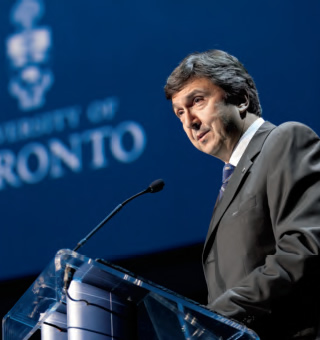Through the centuries, universities and their towns or cities have sometimes progressed in parallel, and sometimes not. The University of Toronto has been very lucky in this geographic lottery, and continues to benefit from the development of the Toronto metropolitan region.
Regional growth has yielded an outstanding and everexpanding pool of local applicants. It also drove the creation of our east and west campuses in the 1960s, leading in turn to more choices for our students and U of T’s unique regional academic system. The arrival of an extraordinary number of immigrants has made our campuses a diverse mirror of the region and the world. Moreover, we’ve benefited from partnerships with outstanding hospitals, cultural institutions, municipalities, social agencies and a huge array of investor-owned and non-profit enterprises alike.
These regional opportunities – academic and otherwise – and the diversity of the region have helped the university attract faculty, staff and students from across Canada and around the world. In turn, the university’s global prominence arguably adds lustre to the metropolitan Toronto region.
Synergy between academic institutions and their regions is nothing new. We see it, for example, in the emergence of Silicon Valley. Students and faculty at Stanford and Berkeley are certainly part of that success story. Perhaps surprisingly, Toronto has also emerged as a globally recognized innovation hub. The region places fourth in the OECD for entrepreneurship, and recently was ranked fourth worldwide for startups in information and communications technology. It hasn’t hurt one bit to have three U of T campuses in the region. In 2011 alone, the university itself spawned 25 new companies. And thousands of our remarkable alumni throughout the region are leaders in the Toronto startup revolution.
This spring, addressing the Toronto Board of Trade, I acknowledged our geographic good fortune and shared some evidence of it. Among the statistics: Toronto is the third-largest financial and digital media centre and the fourth-largest health sciences and biotechnology cluster in North America. Furthermore, even a conservative estimate shows that the Toronto region contributes more to Canada’s GDP in percentage terms than what New York, Chicago and Boston combined contribute to the United States’ GDP. But those numbers are only part of a larger and more complex story. The Toronto region’s outsized clout reflects consistent multi-sector strength. And that strength doesn’t simply add up. Through cross-sector convergence, it has multiplicative or synergistic effects.
The Toronto design sector – the third-largest in North America – provides a telling example. More than 28,000 designers work in the region. The design sector depends on strengths in information and communications technology, marketing and advertising, product development, and the creative and cultural industries. And of course, great design drives success in these areas. Once again, it’s about convergence.
The same could be said of your university. As I’ve written elsewhere, Toronto is one of a handful of universities in the world consistently ranked as top-tier across all major disciplines. This characteristic – coupled with the curiosity and creativity of our faculty and students – facilitates interdisciplinary synergy. It’s a terrific asset for education as well as scholarship and research.
How can the University of Toronto amplify this success? In my view, we need to build more national and international networks. Regions and institutions are only as good as their partners. This is part of a modern Copernican revolution: away from the zero-sum game of “brain drain” versus “brain gain,” and into the new world of “brain chains” – interlocking jurisdictions that are stronger together. It’s multiplicative convergence again: this time in terms of populations, cultures and perspectives. And in this task, we are extraordinarily fortunate to have a distinguished alumni community stretching from sea to sea to sea in Canada, and spanning over 170 countries around the world.
There are different versions of the old tale of the three princes of Serendip. What the versions have in common are the importance of the princes’ education, a narrative of travel and return, and the enduring influence on human affairs of simple good fortune. We truly have serendipitous circumstances – and hope that, wherever you live or travel, you will continue to regard the University of Toronto’s three campuses as a second home.
Sincerely,
David Naylor
Read the complete speech to the Toronto Board of Trade
Visit David Naylor’s blog
Recent Posts
U of T’s 197th Birthday Quiz
Test your knowledge of all things U of T in honour of the university’s 197th anniversary on March 15!
Are Cold Plunges Good for You?
Research suggests they are, in three ways
Work Has Changed. So Have the Qualities of Good Leadership
Rapid shifts in everything from technology to employee expectations are pressuring leaders to constantly adapt







2 Responses to “ Serendipitous Circumstances ”
I agree with David Naylor's well-phrased comments, as I often do.
But I do have one worry: I have no argument against universities seeking a global presence as part of a growth strategy, but if to achieve greater prominence we increase diversity amongst faculty, staff and students, do we not risk forgetting Canadian values? How well does the current U of T community understand the character, history and culture of Canada? Do newcomers to Canada appreciate that being a citizen or resident of this country comes with an obligation and responsibility to protect and enhance its future?
To some, this may sound overly nationalistic. But when I look at the situations people deal with in many other countries, I feel doubly blessed that I was born and grew up in Canada and now live in the United States. I wonder if recent generations hold similar patriotic beliefs. And does the University of Toronto, as a Canadian institution, have a role in reminding the new generation what Canada is all about
Richard M. Clarke
BASc 1954
Westport, Connecticut
U of T had the geographic good fortune to end up owning the lands surrounding the David Dunlap observatory but instead of showing leadership in the preservation of green space within the expanding urban sprawl they simply cashed in. By doing so they have aligned themselves with many other large corporate entities of the new millennium driven by the goals of expansion and greed.